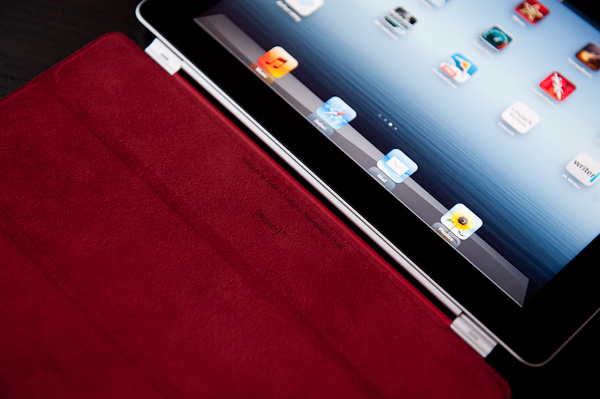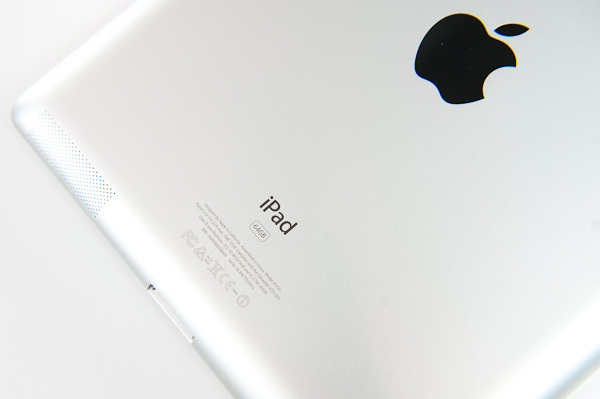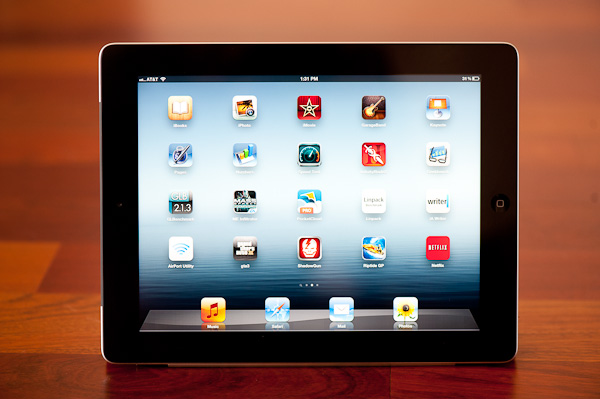The Apple iPad Review (2012)
by Vivek Gowri & Anand Lal Shimpi on March 28, 2012 3:14 PM ESTFinal Words
The new iPad represented Apple’s largest tablet launch yet, and according to their sales figures, three million units were moved over the opening weekend. That’s nearly $2 billion in tablets...in three days. Hotcakes are selling like iPads these days.
The new iPad is externally very similar to the iPad 2, but my feeling is that there's a much larger step in usability from the iPad 2 to the new iPad than there was from the original to the iPad 2. It's a difference that has nothing to do with form factor and everything to do with the Retina Display. The iPad 2 took the original iPad and made it better or more refined in every way—thinner, lighter, faster—but the experience didn't change radically. The Retina Display represents a fundamental change in how you visually interact with the device. The display is really the center of a tablet's experience, and with a display that drastically improved, the experience is correspondingly better.
It really is something that you notice in every single way you use the tablet. Text, whether you're reading it or writing it, is rendered far more accurately. High resolution graphics look fantastic, and UI elements look sharp in a way that the iPad 2 simply cannot match. Compared to the original iPad, the difference is stark, and it’s impossible to emphasize how huge a step up from the original 9.7" XGA display the Retina Display really is. It's a bit like the jump from SD to HD television, or from DVD to Bluray. Functionally, it's not terribly different, but it's a fundamental leap in technology. And once you take that leap, it's difficult to go back.
If you pay for and frequently use a cellular data plan on your iPad, the new iPad is worth the upgrade for LTE alone. LTE is very impressive on a smartphone but you're limited by how much downloading/browsing/multitasking you're willing to do on a very small screen. On a tablet, you're much more likely to treat the device like an ultraportable notebook, in which case an LTE iPad has a huge advantage over most WiFi-only ultraportables. LTE on the iPad is just like having awesome WiFi wherever you go. It's great.
I prefaced all of this with a question about your willingness to pay for the data plan, because even though you're not bound by any sort of a contract, the cost per GB transferred over LTE on both AT&T and Verizon is just unreasonable. If these carriers don't raise their data limits soon, they'll be directly responsible for stifling the growth of the mobile market. Can you imagine what the Internet revolution would've been like had we remained on hourly billing for cable/DSL?
Apple continues to push the envelope on the SoC side as well. Shipping a 163mm2 SoC on a 45nm LP process is something I never expected Apple to do, but it's here and will hopefully encourage other, actual SoC vendors to start behaving like good chip design companies and not like commodity peddlers. We need faster CPUs and GPUs in a major way; Apple can't be the only company aggressively pursuing these needs if others want to be successful. No one ever won by being the slowest on the block.
With all of this said—should you buy the new iPad?
If you are an existing iPad owner, the question is whether or not you should upgrade. If you don't use your iPad all that much, the upgrade obviously isn't worth it. Even if you do use your iPad a lot, unless you're going to use LTE, there isn't a functional or performance advantage to the new iPad. As is always the case, if you can hold off there's always something better around the corner. In this case, next-year's model should bring with it better performance and an increase in power efficiency thanks to 28/32nm silicon. There the decision really boils down to how much you'd appreciate the Retina Display—and as we already mentioned, there's a lot to appreciate.
If you have an iPad 2 you actually end up making a bit of a battery life and portability trade off if you choose the new iPad. It's still not as bulky as a MacBook Air (which already isn't bulky) but it's noticeably heavier than the iPad 2. The new iPad is nicer to use, but it's not as nice to carry. If you're still on the original iPad and use it frequently, the upgrade is a no brainer—you get a faster platform, a lighter chassis, better display and better cellular connectivity (optional).
If you're not a tablet owner, are in desperate need of one, and are looking to buy one now—the new iPad is as good as it gets today. This is Apple's halo iDevice. It has the fastest and best of nearly every component inside and out. It's got everything but the kitchen sink. As long as you're ok with iOS, there's no reason not to get the new iPad.













234 Comments
View All Comments
Steelbom - Thursday, March 29, 2012 - link
I'm curious why we didn't see any graphics benchmarks from the UDK like with the iPhone 4S review?Craig234 - Thursday, March 29, 2012 - link
Wow, this is good to buy... 'if you are in desperate need for a tablet'?That's a pretty weak recommendation, I expected a much stronger endorsement based on the review.
Chaki Shante - Friday, March 30, 2012 - link
Great, thorough review, thanks Anand et al.Given the sheer size of the SoC (like 4x larger then Tegra2 or OMAP4430, and 2x Tegra3), you'd bet Apple has the fastest current SoC, at least GPU-wise.
This SoC is just huge and Apple's margin is certainly lowered. Is this sustainable on the long run ?
I wonder if any other silicon manufacturer could make same size devices (not technologically but from a price perspective) and expect to sell them.
dagamer34 - Friday, March 30, 2012 - link
No one else needs to crank out so many chips that are the same. Also, other companies will be waiting long enough to use 28nm, so there's little chance they'll be hitting the same size as the A5X on 45nm.Aenean144 - Friday, March 30, 2012 - link
Since Apple is both the chip designer/licensee and hardware vendor, it saves them the cost of paying a middleman. Ie, Nvidia has to make a profit on a Tegra sale, Apple does not, and can afford a more expensive chip from the fab compared to the business component chain from Asus to Nvidia to GF/TSMC and other IP licensees.I bet there is at least 50% margin somewhere in the transaction chain from Asus to Nvidia to GF/TSMC. Apple may also have a sweetheart IP deal from both ARMH and IMGTEC that competitors may not have.
shompa - Friday, March 30, 2012 - link
@Aenean144Tegra2 cost 25 dollars for OEMs and 15 dollars to manufacture. A5 cost Apple 25 dollars to manufacture. By designing its own SoC Apple got 30% larger SoC at the same price as Android OEMs.
Tegra3 is huge. That is a problem for Nvidia. It costs at least 50% more to manufacture. Nvidia is rumored to charge 50 dollar for the SoC.
A5X is 50%+ larger then Tegra3. Depending of yields it cost Apple 35-50 dollar per SoC.
The integrated model gives Apple cheaper SoCs, but also custom designed for their needs. Apple have a long history of Accelerating stuff in its OS. Back in 2002 it was AltiVec. Encoding a DVD on a 667mhz powerbook took 90 minutes. The fastest X86 AMD 1.5ghz it took 15 hours. (and it was almost impossible to have XP not bluescreen for 15 hours under full load). Since 2002 Apple accelerate OSX with Quarz Extreme. Both these techniques are now used in iOS with SIMD acceleration and GPU acceleration. Its much more elegant then the brute force X86 approach. Integrated makes it possible to use slower, cheaper and more efficient designs.
shompa - Friday, March 30, 2012 - link
The A5X SoC is a disaster. Its a desperation SoC that had to be implemented when TSMC 28nm process slipped almost 2 years. That is the reason why Apple did not tape out a 32nm A5X on Samsung. PA Semi had to crank out a new tapeout fast with existing assets. So they took the A5 and added 2 more graphics core.The real A6 SoC is probably ready since long back, but TSMC cant deliver enough wafers. The rumored tapeout for A6 was mid 2011. Apple got test wafers from TSMC in june and another batch of test wafers in october. Still at this point Apple believed they would use TSMC for Ipad3.
ARM is about small, cheap and low power SoCs. That is the future of computing. The A5X is larger then many X86 chips. Technically Intel manufactures many of its CPUs cheaper then Apple manufactures the A5X SoC. That is insane.
stimudent - Friday, March 30, 2012 - link
Products reviews are fun to look at, but where there's a bright side, there is always a dark side. Maybe product scoring should also reflect how a manufacturer treats its employees.name99 - Friday, March 30, 2012 - link
You mean offers them a better wage than they could find in the rest of China, and living conditions substantially superior to anywhere else they could work?Yes, by all means let's use that scoring.
Or perhaps you'd like to continue to live your Mike Daisey dystopia because god-forbid that the world doesn't conform to your expectations?
Craig234 - Friday, March 30, 2012 - link
I'm all for including 'how a company treats its employees' and other social issues; but I'd list them separately, not put them in a product rating.